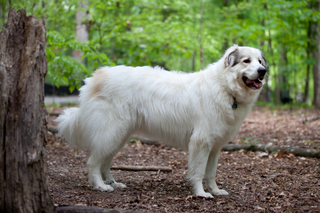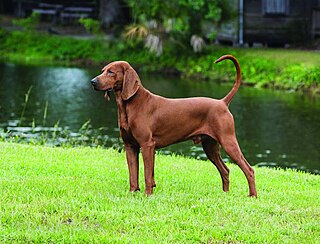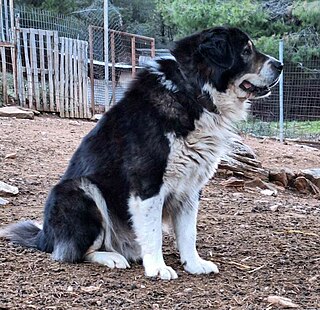
The Catahoula Leopard Dog is an American dog breed named after Catahoula Parish, Louisiana. It became the state dog of Louisiana in 1979. It is recognized by the United Kennel Club under the name Louisiana Catahoula Leopard Dog, while the American Kennel Club Foundation Stock Service calls it Catahoula Leopard Dog. Both registries have assigned the breed a herding designation, although it has traditionally been used in hunting feral boars.

The Shetland Sheepdog, also known as the Sheltie, is a breed of herding dog that originated in the Shetland Islands of Scotland. It was formally recognized by The Kennel Club in 1909. It was originally called the Shetland Collie, but this caused controversy amongst Rough Collie breeders of the time, so the name was changed. It is a small dog, clever, vocal, willing to please, and trustworthy.

The Pyrenean Mountain Dog or Chien de Montagne des Pyrénées is a French breed of livestock guardian dog; in France it is commonly called the Patou. It originates from the eastern or French side of the Pyrenees Mountains that separate France and Spain and is recognised as a separate breed from the Mastín del Pirineo or Pyrenean Mastiff from the Spanish side of the mountains, to which it is closely related.

The Swedish Vallhund, also known as the Västgötaspets and Swedish cow dog, is a breed of dog native to Sweden. The breed's name, Vallhund, when translated into English, means herding dog, as the Swedish Vallhund was originally bred as a drover and herder of cows over 1,000 years ago. In 1942, the dog came close to extinction, but careful breeding and publicity by Swedish national Björn von Rosen and K. G. Zettersten managed to revive the breed in popularity and save it from its likely end. In 1943, the Swedish Kennel Club recognized the Swedish Vallhund as a breed, and officially categorized the Swedish Vallhund as "the Västgötaspets" for Västergötland, the province in which their revival took place. Since then, the breed has been recognized by, and bred in, over ten countries and has gained some popularity.

The Australian Cattle Dog, or simply Cattle Dog, is a breed of herding dog developed in Australia for droving cattle over long distances across rough terrain. This breed is a medium-sized, short-coated dog that occurs in two main colour forms. It has either red or black hair distributed fairly evenly through a white coat, which gives the appearance of a "red" or "blue" dog.

Collies form a distinctive type of herding dogs, including many related landraces and standardized breeds. The type originated in Scotland and Northern England. Collies are medium-sized, fairly lightly-built dogs, with pointed snouts. Many types have a distinctive white color over the shoulders. Collies are very active and agile, and most types of collies have a very strong herding instinct. Collie breeds have spread through many parts of the world, and have diversified into many varieties, sometimes mixed with other dog types.

The Entlebucher Sennenhund or Entlebucher Mountain Dog is a medium-sized herding dog, it is the smallest of the four regional breeds that constitute the Sennenhund dog type. The name Sennenhund refers to people called Senn, herders in the Swiss Alps. Entlebuch is a region in the canton of Lucerne in Switzerland. The breed is also known in English as the Entelbuch Mountain Dog, Entelbucher Cattle Dog, and similar combinations.

The Smooth Collie is a breed of dog developed originally for herding. It is a short-coated version of the Rough Collie of Lassie fame. Some breed organisations consider the smooth-coat and rough-coat dogs to be variations of the same breed.

The Belgian Shepherd, also known as the Belgian Sheepdog or the Chien de Berger Belge, is a Belgian breed of herding dog of medium size. It is bred in four distinct varieties based on coat type and colour: the long-haired black Groenendael; the rough-haired fawn Laekenois; the short-haired fawn Malinois, and the long-haired fawn Tervuren. The American Kennel Club considers the four varieties to be separate breeds.

The Briard or Berger de Brie is a French breed of large shepherd dog, traditionally used both for herding sheep and to defend them. It was first shown at the first Paris dog show, in 1863; the first Briard to be registered in the Livre des Origines Françaises, the national stud-book, was Sans Gêne in 1885. It was in the past also known as the Chien de Berger français de Plaine.

The Finnish Spitz is a breed of dog originating in Finland. The breed was originally trained to hunt all types of game from squirrels and other rodents to bears. It is a "bark pointer", indicating the position of game by barking, and drawing the game animal's attention to itself, allowing an easier approach for the hunter. Its original game hunting purpose was to point to game that fled into trees, such as grouse, and capercaillies, but it also serves well for hunting elk. Some individuals have even been known to go after a bear. In its native country, the breed is still mostly used as a hunting dog. The breed is typically friendly and good with children, so it is suitable for domestic life. The Finnish Spitz has been the national dog of Finland since 1979.

The Bouvier des Flandres is a herding dog breed originating in Flanders, Belgium. They were originally used for general farm work including cattle droving, sheep herding, and cart pulling, and nowadays as guard dogs and police dogs, as well as being kept as pets.

The Fila Brasileiro is a Brazilian breed of large working dog of mastiff type.
Canine terminology in this article refers only to dog terminology, specialized terms describing the characteristics of various external parts of the domestic dog, as well as terms for structure, movement, and temperament. This terminology is not typically used for any of the wild species or subspecies of wild wolves, foxes, coyotes, dholes, jackals or the basal caninae. Dog terminology is often specific to each breed or type of dog. Breed standards use this terminology in the description of the ideal external appearance of each breed, although similar characteristics may be described with different terms in different breeds.

The Cane Corso is an Italian breed of mastiff. It is usually kept as a companion dog or guard dog; it may also be used to protect livestock. In the past it was used for hunting large game, and also to herd cattle.

The Coton de Tuléar is a breed of small dog named for the city of Tuléar in Madagascar. This breed is thought to have originated from a group of small white dogs that swam across the Malagasy channel following a shipwreck. Known for its cotton-like coat, the Coton de Tuléar typically grows to no more than 18 pounds (8.2 kg), and are white, sometimes with grey, tan, black, or tri-colored markings. The Coton de Tuléar Day is celebrated on November 26.

The Redbone Coonhound is an American breed of hunting dog. As a coonhound, the Redbone is primarily a hunter of small game that hide in trees, such as raccoons, opossums, and squirrels, but is also capable of handling big game like bears and cougars. Its hunting strategy is to tree wild game where hunters can then shoot the target, rather than directly hunting and subduing the prey.

The Berger Picard or Picardy Shepherd, is a French herding dog originating in Picardy. These dogs nearly became extinct after both World War I and World War II and remain a rare breed.

The Portuguese Sheepdog is a medium-sized breed of dog of the herding dog type, and is one of the indigenous regional dogs of Portugal. The Portuguese name refers to Serra de Aires, a mountain near Montforte in the Alentejo region. The breed is nicknamed cão macaco for its furry face and lively attitude.

The Greek Shepherd or Greek Sheepdog is a breed of livestock guardian dog from Greece. Thought to be ancient in origin, the Greek Shepherd is very closely related to livestock guardian dog breeds from neighbouring countries; it is believed that some dogs are simultaneously claimed to be other breeds as they migrate annually across national borders with the flocks they protect in search seasonal pastures.























